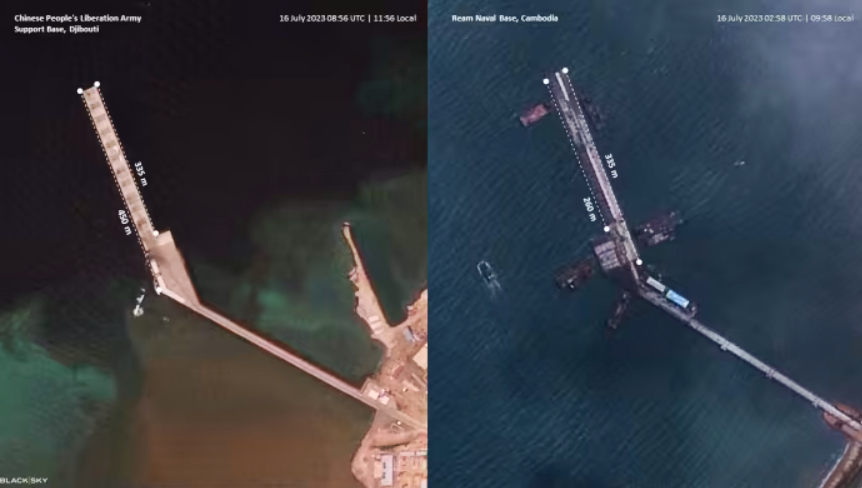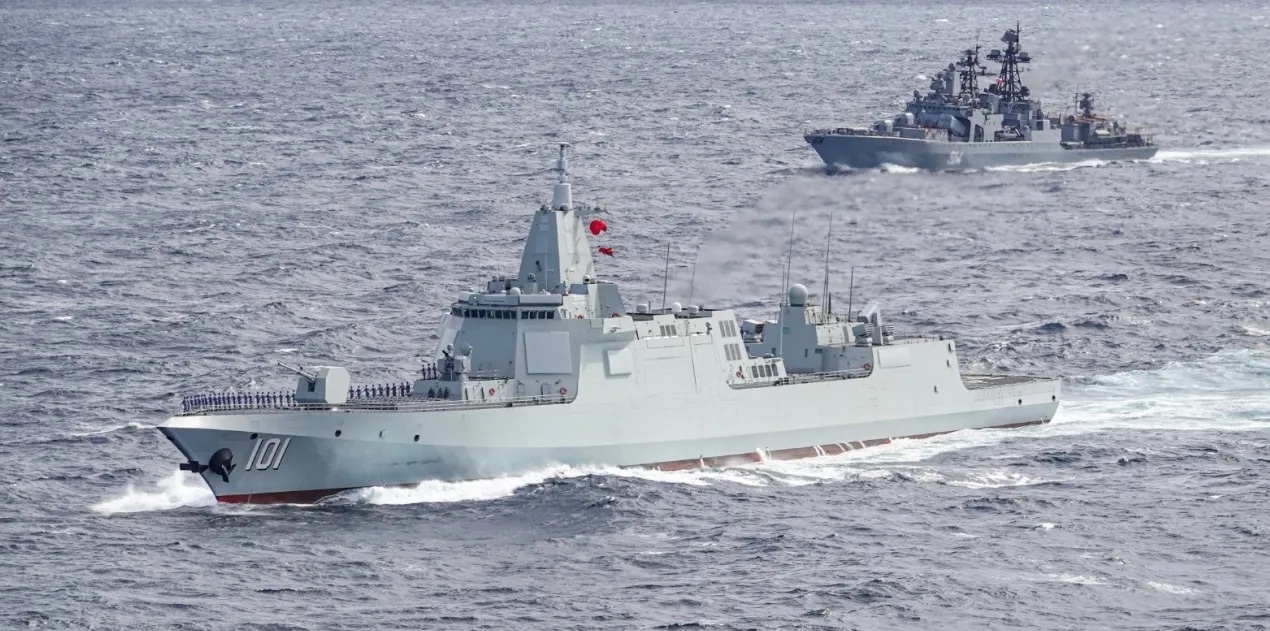China’s only overseas military base besides Djibouti is up and running. Satellite imagery indicates that two Chinese navy ships have been docked at Cambodia’s Ream Naval Base for over four months.
A new satellite imagery analysis has shown that the two warships of the People Liberations Army-Navy have been docked for extended periods at the new pier despite repeated concerns expressed by the United States. The base in Cambodia is meant for repair, and replenishment will also have repercussions for India, as it will shorten the time taken to reach its maritime area of dominance.
The two Chinese warships were first seen at Ream on December 3 in a Facebook post by Cambodia’s Defense Minister Tea Seiha, who said that the ships were there for training engagements with the Cambodian Navy. In January 2024, Radio Free Asia reported that they had left the base before they were spotted again in March imagery of Ream in a report by Nikkei.
An analysis done by the Asia Maritime Transparency Initiative (AMTI) of the CSIS think tank indicates that the PLA warships never left Cambodia and have had a sustained presence in the country for over four months now.
The AMTI assessed a slew of photographs to conclude that the PLAN ships were visibly docked at Ream’s new pier during 93 percent (85 of 910 dates). The pier was only seen empty for two brief periods in 2024, from January 15-18 and March 29-30.
The presence of the Chinese warships comes as the US and Australian-funded facilities along the north-western coast have been razed and the area paved with concrete.
The construction around the Ream base appears aimed at housing Chinese personnel. A 2019 memorandum of understanding granted China exclusive access to the base. If the long-term presence of the two warships is any indication, Chinese naval vessels could be foreseen to be deployed to Ream for long stints.
“Satellite imagery also showed no other ships, including any Cambodian vessels, docking at the new pier, which was completed last year (2023) to enable larger warships to dock in Ream’s shallow waters,” the AMTI report said.
“While previous language from then prime minister Hun Sen had claimed that the base’s upgraded facilities would be open to visits from all navies, two Japanese destroyers that made a port call in February were routed to Sihanoukville Autonomous Port rather than Ream. Cambodian boats at Ream have continued to cluster at the base’s older, smaller pier to the south,” the report adds.
The facilities will help deploy warships and coastguard vessels around the region at short notice, increasing China’s footprint in the region. In addition, more accessible access to Southeast Asian Sea lanes like the vital Straits of Malacca would enhance logistics and intelligence monitoring.
The aircraft carrier-size pier at Ream base and dry dock facilities will provide the PLA-N with an extended presence in the Bay of Bengal and affect the balance of power in the region.
According to AMTI, construction at the Ream Naval Base has progressed by “leaps and bounds” since AMTI’s last examination, with some key upgrades now nearing completion.
In the southwest, a new wharf and drydock are taking shape that would further expand available docking capacity and enable maintenance and repair operations on larger ships. Cambodia’s small Navy has no vessels in its flotilla, which requires such an extensive facility. This suggests that the Chinese Navy will have a permanent presence at the base.
Large land clearings in the north and northwest of the base have now been filled in with warehouses, administrative complexes, and what appear to be living quarters—complete with four regulation-size basketball courts.

In the southwest, over 60 acres of land have been cleared for new construction in what was previously an unused area covered in vegetation.
The Chinese and Cambodian governments have previously denied reports that Cambodia will allow a Chinese military presence at the Ream naval base on the Gulf of Thailand. The base would significantly increase China’s access to the Indo-Pacific, as presently, the country has only one naval base in the East African country of Djibouti.
China is adding a third aircraft carrier, Fujian, to its armada. They align with China’s ambition to become the leading strategic power in Asia-Pacific, but countering the US will be challenging without a global chain of overseas bases.
Cambodia has confirmed receiving aid for building the facilities but has asserted that they are meant for national defense. The ground-breaking ceremony of the naval base site was held in 2022, and China’s ambassador to Cambodia attended it, too.
The former deputy prime minister of Cambodia, Tea Banh, said: “Ream Naval Base is small. Therefore, we must upgrade our base to protect our nation, territory, and sovereignty. Ream Naval Base’s modernization project is an important strategy for developing the Royal Cambodian Armed Forces by the Ministry of National Defence’s White Paper.”
Cambodia is the closest ASEAN nation to Beijing, which has long courted Prime Minister Hun Sen with billions of dollars in murky infrastructure loans and development projects involving close cronies. The US and Cambodia have been drifting apart. In 2017, then-US Ambassador to Cambodia William Heidt said that the Cambodian government was “not interested in a positive relationship” with the US.
China’s footprint in Cambodia has only grown since. According to some reports, Cambodia has repeatedly been the sole ASEAN member to scuttle joint communiques on the disputed South China Sea, even sharing their drafts with Chinese officials.

While China’s overseas military network bases are nowhere near that of the US, Beijing has been trying to exert influence. In 2021, the Wall Street Journal reported that US intelligence agencies learned that Beijing was secretly building a military installation at a port near the Emirati capital of Abu Dhabi. The Journal reported that construction was halted after the US government doubled down on the UAE. The current status of the project is unclear.
The base at Ream is a security concern for Vietnam. It is not happy to see China moving closer to its territory as it has ongoing sovereignty disputes with China in the South China Sea, and the overall trust between the two countries is low.
China’s experience in the “far seas” began in 2007 with an anti-piracy mission in the Gulf of Aden. The PLA Navy’s 43rd task force arrived off the Horn of Africa this past February to begin the country’s 15th year escorting merchant ships past Somalia’s turbulent coastline.
In 2017, the Chinese Navy began operating a support base in Djibouti alongside other foreign militaries, including the US Navy, to guard approaches to and from the Suez Canal. The pier at the facility, which also has a runway, was expanded in 2021 to accommodate large warships, including future carriers.
- Ritu Sharma has been a journalist for over a decade, writing on defense, foreign affairs, and nuclear technology.
- The author can be reached at ritu.sharma (at) mail.com
- Follow EurAsian Times on Google News




